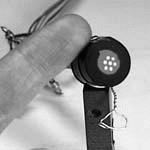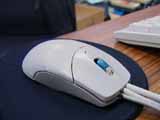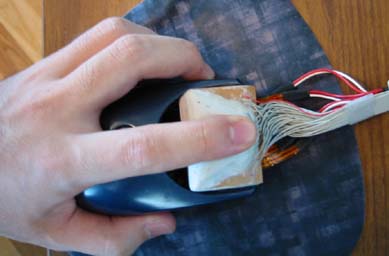

The purpose of our research is to make tactile feeling as a kind of
sensation which can be recorded, reproduced, and transmitted,
just like vision and auditory sensations.
We separate this goal into two parts. One is a tactile display, by which
we could feel any kinds of cutaneous sensations. The other is a tactile
sensor, by which we collect contact information from real objects.
Ultimately, we combine these two into one tactile information
system. Though there have been many works on tactile sensors and
displays, most of them were done separately and didn't consider making
total system.
Tactile Display
Until now, we were working on tactile feeling display.





``Tactile feeling'' is a sensation produced in our skin when we touch
or rub something. If we generate tactile feeling in VR(Virtual Reality)
space, we can not only experience more realistic presence, but also
perform more difficult tasks.
Most previous works on tactile display are variations of pin-head
type, or belt type displays, which vibrate vertically or horizontally on
the skin. They are mechanical devices and have some difficulties. They
are huge, difficult to fabricate, and not able to produce all kinds of
tactile sensations.
Some other studies proposed to use electrical current as a
stimulus. Though fabrication becomes much easier, most of them lacked
principle and stayed ad-hoc system, because they didn't fully understand
what was happening inside skin.
Our first approach was to consider mechanisms of tactile
sensations. There are four types of mechanoreceptors in human skin and
tactile sensation is basically a combination of these receptors'
activity. Therefore, if we could stimulate these receptors separately,
we could generate any sensations. We name these stimuli ``tactile
primary colors'' after three primary colors (RGB) in vision, which stimulate
different types of cone cells in human retina. Our main finding was
that by using electrical stimulation, we could realize these primary
colors.
We considered mechanisms of electrical stimulation. There are two
processes in it. One is a map between current source distribution on
skin surface (I(x,y)) and external potential along afferent
nerves(V). The other is a map between this potential and membrane
potential difference (Vm). Writing these maps mathematically, we
derived activation probability of nerve as a function of current source
distribution. Consequently, the problem of stimulating specific nerves
is generalized to mini-max problem of this function.
We found out that by utilizing each receptor's geometry, we can
separately stimulate each type of mechanoreceptors in two ways. One is
to use arrayed electrodes instead of a single one. The other is to use
an anodic current as a stimulus, as well as a cathodic current.
We also developed experimental system and tested these
methods. In each stimulation mode, subject felt sensation of pressure,
low frequency vibration, and high frequency vibration separately. These
results implies that the designed stimuli
succeeded in activating desired mechanoreceptors' axons.
As our display system uses array electrodes, making multi-position
stimulation was achieved easily. By scanning, we succeeded in presenting
sensation of movement (apparent movement).
Some practical problems arose. As skin impedance changes with
time and place, and nerve activity largely depends on it, our generated
sensation is not at all stable. Now we are making a system that utilizes
electrodes as an impedance sensor. By using the information of the state
of the skin, we will control input current dynamically to compensate for
the variation of skin.
Tactile Sensor (Dummy Finger)
To develop tactile sensor that gathers contact information and sends it
to the tactile display, we utilize the fact that our tactile display is
capable of stimulating each type of mechanoreceptors separately. There
are two approaches.
One is to get all precise data of an object that is related to touch;
such as height, friction coefficient, elasticity, and so forth. Once the
information is acquired, we simulate each receptor's behavior to
calculate the tactile display's output.
The other approach is to make a tactile sensor that has artificial
mechanoreceptors inside. These receptors gather information that real
mechanoreceptors do. In this case, the sensor body should have the same
mechanical dynamics as a real finger. Because of the resemblance with
auditory dummy head, we name it ``dummy finger.''
Reference